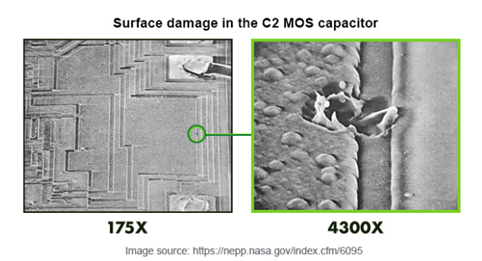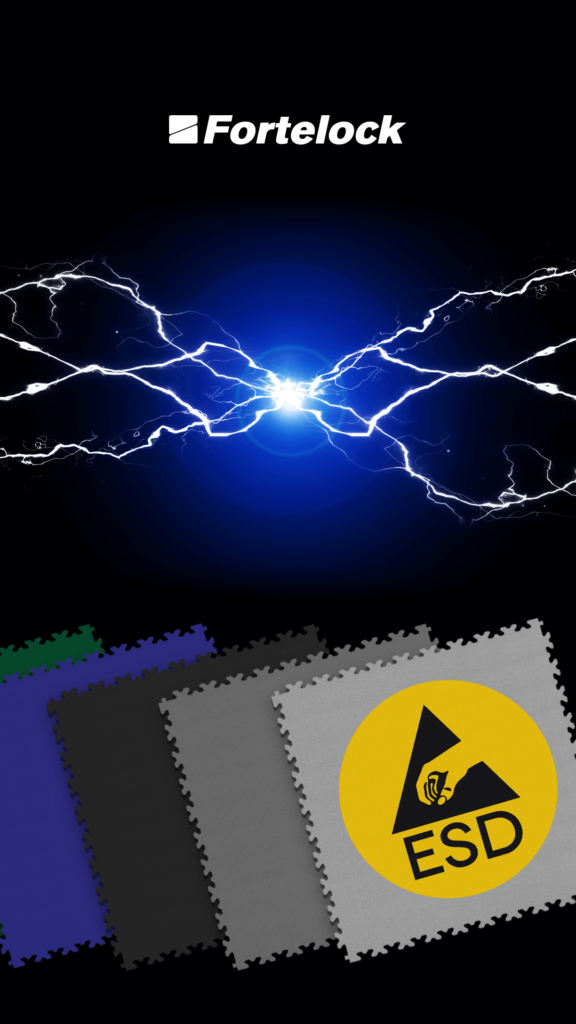What Is ESD and What Does ESD Flooring Do?
ESD is responsible for damages of several billion US dollars worldwide. Estimates put the cost of damages from ESD to electronic component manufacturers at 8 to 30 percent of all manufacturing defects. This makes preventing such damage extremely important. Fortelock ESD flooring can help.
What is ESD?
ESD stands for electrostatic discharge. A charge forms when two surfaces rub against each other or are pulled apart (e.g. adhesive tape). This causes neutral atoms to take on a positive or negative charge. If these charged atoms then come into contact with a grounded element, electricity is released.
We have all experienced this first-hand, especially in the winter months when just touching a doorknob can give a “shock”. That is because the air is so dry in winter that it has trouble dissipating accumulated electrical charges. Just walking on a carpet or putting on a wool sweater can accumulate a huge charge.
The Body as a Big Battery
Did you know that just getting up from a chair can generate a charge of up to 18,000 volts? Take off your wool sweater and you will create a charge of up to 25,000 V. Walk on a nylon carpet in a dry environment and you can quite easily accumulate up to 35,000 V!
You can hear the discharge as soon as the body has accumulated 6,000 V – that’s the crackle you hear. At a charge of 9,000 V you can see a spark.
What Affects the Amount of Charge?
Several factors affect how much charge there is. One of the most important is relative air humidity. In a humid environment, a charge simply escapes along the conductive path formed by water droplets in the air. In winter, though, it is harder for the charge to dissipate, so where handling a plastic bag in the summer generates a voltage of 1,600 V, in winter it can be up to 17,000 V.
| Relative air humidity | 20% | 80% |
| Walking on nylon carpet | 35,000 V | 1,500 V |
| Taking off a wool sweater | 25,000 V | 1,900 V |
| Getting up from a chair | 18,000 V | 1,800 V |
| Handling a plastic bag | 17,000 V | 1,600 V |
| Walking on a vinyl floor | 12,000 V | 250 V |
| Working with plastic | 6,000 V | 100 V |
Another important factor is the type of material. If you rub a balloon against your hair, the amount of charge will be enormous. That is because these materials have opposite susceptibilities to charge. While hair charges positively, rubber and plastic tend to charge negatively. This difference creates a great charge. If you would like to learn more, have a look at the “triboelectric series”.
How fast we walk across the carpet or unwind the tape also affects the amount of charge. The slower we walk, the less charge there will be. And finally, there is how large the contact area of the materials is. The larger the area, the greater the charge.
Delicate Electronics
Manufacturers really only started addressing the issue of ESD in the 1970s. Up until then electrical components were big and robust and could withstand higher voltages, but all that changed as products got smaller. Old-fashioned television sets have been replaced by thin LCD units, phones now fit into a pocket, and desktop computers have given way to compact laptops and tablets. These devices all require the smallest components possible.
Did you know that the smallest chip today measures only 0.1 mm3?
These components are all extremely sensitive to higher voltages. Even 20 volts can cause irreversible damage. But what is most insidious about ESD is that it can also cause just partial damage, while the component continues to function. Not even an exit inspection will detect such damage. Defects can be so small that they escape detection by the naked eye. The extent of the damage is only apparent after zooming in several thousand times. Over time, however, the damage can increase until it results in complete product failure. In many cases, this happens while the product is still under warranty, incurring huge costs for the manufacturer for repairs or replacement.

Where Can We Encounter ESD and What Can Be Done about It?
Preventing ESD is extremely important for manufacturers. And not only for them. It can also cause major problems in other sectors such as:
- Airports
- Textile and paper industries
- Paint shops
- Dryers
- Photographic industry
- Pharmaceutical industry
- Operating theatres
- Dental offices
- Logistics centres where products are packed and handled
ESD prevention programs focus on two primary goals –minimizing the risk of electrostatic discharge as much as possible, and slowly bringing the charge to ground when it does occur.
For effective, efficient ESD prevention, we recommend implementing a company ESD suppression program. One of the things this involves is establishing an electrostatic discharge protected area (“EPA”). That is a space within which the risk of ESD is minimised. This can be a single workstation handling fine electronics or an entire production hall. Among other things, it includes:
1. ESD equipment: special ESD wristbands, ESD flooring, ESD footwear and clothing, ESD containers, chairs, lamps, tools, packaging material and more.
2. Measuring device at the entrance to the EPA: measures the voltage value on the human body and the system resistance formed by the worker and the footwear.
3. Trained staff: as part of the programme, it is important to train staff on how to enter the space and how to work in it.
4. ESD coordinator: each company should have its own coordinator to carry out regular checks, train new staff and ensure that the programme is working properly.
Tip: If your work is mostly sedentary and you only come into contact with electronics at a single desk, you should at least get some ESD wristbands. They can effectively dissipate static charge. But if you need to move and walk while you work, invest in quality ESD flooring. It does not create electrical charge and effectively draws any charge to a grounding point.
Contact our experts for more information, technical specifications or an individual offer. We are ready to help you find the best floor solution to meet the specific requirements of your industrial space.

